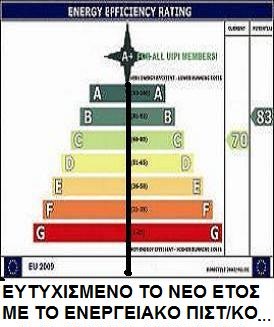1. Minimum Energy Performance Requirements for New Buildings (articles 4 & 6).All new buildings or building units must meet the minimum energy performance requirements as specified in KENAK (ref. c’) and are specialized in TOTEE 20701-1/2017 “Detailed national parameter specifications for the calculation of the energy efficiency of buildings and the issuance of the energy efficiency certificate” (ref. e’) and especially in chapter 7 thereof. The following categories of buildings are excluded:
a) protected buildings as part of a specific environment or because of their particular architectural or historical value, to the extent where compliance with certain minimum energy performance requirements would unacceptably alter their character or appearance. The “monuments”, in the sense of Law 3028/2002 “For the protection of Antiquities and in general the Cultural Heritage.” (A’ 153) fall into this category.
b) buildings used as places of worship. It refers exclusively to buildings or building units that have a legal urban planning use of a place of worship (known & recognized religion) regardless of ownership status. Buildings or building units used by religious organizations as dormitories, offices, schools, etc. do not fall into this category of exemptions.
c) industrial and craft facilities, professional workshops with important electromechanical equipment and warehouses – Logistics, factories, maintenance and repair workshops for cars – motorcycles – mopeds, paint shops, carpentry, research and training laboratories, food preparation plants, dry cleaners, ironers, organized laundries and independent computerization centers.
d)temporary buildings, agricultural uses – except residential – and agricultural buildings – except houses – construction site huts, constructions for periodicals – seasonal exhibitions.
e) individual buildings, with a total usable area of less than fifty square meters (50 sq.m.), for which only the minimum requirements relating to structural elements of the building envelope apply.
g)Cases of properties which are not “structural projects” from the urban planning use such as open or closed parking spaces and car washes , pavilions, outdoor theaters & concert venues, self-propelled or towed caravans, livestock – poultry units, stables, slaughterhouses, etc.
2. All existing buildings or building unitssubject to radical renovation must meet the minimum energy efficiency requirements as described in the circular and the law.
<p style="text-align: justify?" 3. In new buildings or building units, it is mandatory to cover part (60%) of the DHW (hot water for use) needs by solar thermal systems.
4. Energy Performance Certificate (PEA). Illustrates the energy rating of a building or building unit to allow owners or tenants of the building or building unit to compare and evaluate its energy performance. The PEA is valid for 10 years from its issuance.
5. The obligation to issue a PEA (article 12) exists:a)after the completion of the construction of a new buildingor building unit and concerns buildings with a building permit that fall under the provisions of KENAK (the permits issued after the start of implementation of KENAK 2010 and fall under its provisions),
b)after the completion of a radical renovation of a building or building unit,
c)when selling a building or building unit, until the activation of the Building Identity,
d) when renting (long-term, short-term, sublease) to a new tenant of a building or building unit, until the activation of the Building Identity,
e) for buildings with a total area of more than two hundred and fifty square meters (250 sq.m), which are used by services of the public and wider public sector, as defined each time, and which are frequently visited by the public. Belonging to this category concerns every service that is open to the public such as the administrative services of local authorities, school complexes, ministries.
6. Exemptions from the obligation to issue a PEA (article 12, par. 6 & 7). Buildings used as places of worship and individual buildings with a total usable area of less than fifty square meters (50 sq.m.) are exempt from the obligation to issue a PEA (cases b’ and e’ of par. 7 of article 4 of the a’), however, the issuance of PEA is possible if the owner so wishes. It is not allowed to issue a PEA for the cases mentioned in paragraph 1 of this.
7. It is mandatory to inform new buyers or tenants about the building’s energy classification through the PEA. During the process of the sale or any type of lease of buildings or building units, the owner or lessor shows the PEA or its copy to the prospective new buyer or tenant before the lease or sales contract is drawn up and its copy is delivered to the new buyer or tenant on sale or lease. The obligation to update it already applies from 9.1.2011 for the new lease of buildings and from 9.7.2011 for the new lease of building units.
The existence of the PEA during the lease (long-term, short-term, sublet) is confirmed with registration of its details in the corresponding online application of AADE.
The free concession is not a lease and the issuance of a PEA is not required (the relationship of the contracting parties is not considered). The granting or renting of part of a building unit does not require the issuance of a PEA since it is not possible to issue a PEA for part of a building unit (e.g. renting a bedroom in an apartment, or part of an apartment for the use of a self-employed business seat),
Consequently there is an obligation to have a valid PEA and to register its details in the corresponding online application of the AADE, if the legislation requires the issuance of a PEA and it is a lease agreement for a new tenant who is moving into the lease for the first time.
Consequently, the above obligation does not exist:
– in case of renewal or extension of the lease agreement with the same tenant of this property.
– when for any reason the lease contract is transferred (e.g. business transformation).
However, if a PEA was not issued when the original contract was concluded, while it was required, then it is issued immediately and delivered to the lessee. Since there is no obligation to issue a PEA, it is clear that there is no obligation to register the PEA in the AADE applications, but it is required to state the reason for the exception (e.g. a building with a usable area of less than 50 sq.m).
< 8. Advertisements – brokerage services. From January 1, 2021 every building or building unit available for sale or rent is required to already have an EIA so that the energy performance index (energy class) is declared in all commercial advertisements and listings, i.e. in every advertisement in the press or in electronic media, as in every post – reference to real estate agencies, the energy category of the building is clearly stated so that the energy classification of the property is a key comparative element for the formation of the choice of the interested buyer / tenant. Brokerage offices can undertake a brokerage mandate on the condition that before any advertising and listing (press, internet, even in posts and directories at their headquarters) they will have the details of a valid PEA. Advertisers, newspapers and online ad pages will not accept ads for publication that do not have an energy class statement.
9. PEA validity checkis based on the protocol number, date of issue and the sixteen-digit security number (see figure 1), entering said data in the relevant field “PEA Validity Check.” of the Energy Inspection Archive on the website www.buildinacert.ar.
10. Imposition of a fine: In case of non-issuance of a PEA (while due), omission of pre-contractual information of the counterparty, advertising – brokerage without reference to the energy classification of the building unit/building and failure to register the details of the PEA in the AADE applications, it is imposed, according to article 20 of Law 4122/2013, a fine against the legally liable person from two hundred (200) to ten thousand (10,000) euros.






